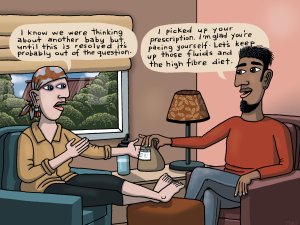Academic pharmacist Nataly Martini highlights the importance of understanding non-Hodgkin lymphoma and pharmacists’ roles in managing this condition
Te Niwha researchers working alongside Māori and Pasifika to boost childhood immunisation rates for the most vulnerable
Te Niwha researchers working alongside Māori and Pasifika to boost childhood immunisation rates for the most vulnerable
Te Niwha researchers are working alongside Māori and Pasifika communities and health organisations to boost childhood immunisation rates for the most vulnerable.
Te Niwha’s ‘Lifting Immunisation Rates in Vulnerable Communities’ research project is led by Te Rau Ora Chief Executive Riki Nia Nia (Ngāti Kahungunu, Ngāi Tūhoe, Tonga), in partnership with communities and iwi in the Counties Manukau and Waikato areas. Nia Nia says while Te Rau Ora has traditionally been involved in Māori mental health workforce development, it has always had a strong research and evaluation focus, and it is great to be given the opportunity to add value in the population and public health space for tamariki.
Researchers are evaluating what delivery and support works to immunise and protect Māori and Pasifika aged under 5 years from infectious diseases. The project will also explore how to lift immunisation rates among pregnant mothers and those with disabilities.
Nia Nia says the study focuses on the Counties Manukau and Waikato regions as childhood immunisation rates among Māori living there are below 50% of the eligible population and the regions are home to the highest Māori and Pasifika communities. However, the proactive findings of this research kaupapa will have relevance across the country.
The research team will host a Māori and Pacific National Immunisation Hui in July this year when experts from Te Ao Pākehā and Te Ao Māori will discuss ways to address this ongoing issue.
“We are looking, together, for ways to help protect our most vulnerable from preventable, common, and sometimes deadly or deeply debilitating conditions such as measles and whooping cough,” says Nia Nia.
Te Niwha is the national infectious diseases research platform established to improve preparedness for future pandemics, build and coordinate research capacity, and continue to address COVID-19 and other serious infectious diseases in Aotearoa New Zealand. The childhood immunisation project is one of scores funded by Te Niwha to boost Aotearoa New Zealand’s prevention, surveillance, testing and treatment of infectious diseases.
Nia Nia says fewer than 42% of six-month-old Māori pēpi in Counties Manukau are fully vaccinated and less than 38% in the Waikato. These dangerously low rates have persisted for more than two years, sparking the need for alternatives to the status quo.
Researchers will work with iwi, hapu, whānau and Pasifika communities to understand perspectives on existing immunisation services; then explore new or previously successful initiatives to lift rates of protection.
They will also explore perspectives on the COVID-19 pandemic and associated vaccination programme, looking for any potential impacts on childhood immunisation rates.
Nia Nia says from his perspective, COVID-19 had a mixed effect.
“The positives were a lot of community involvement and successful iwi, hapu or whānau-led initiatives. There was misinformation, which can lead to diminished trust and understanding. What’s important is whānau have all the information to make informed choices and have safe pathways regardless of the choices they make.”
Te Niwha Mana Whakahaere Director Te Pora Thompson (Ngaati Hauaa) says the Te Niwha founding principles of Accountability, Integrity, Relationships, Partnership and Leadership are key in all the work Te Niwha and its partners do.
“Te Niwha has been clear about building relationships with communities through understanding their impacts and therefore ensuring the research we all undertake is deployable on the ground to really make a difference for those communities. Our commitment to this is embedded in science integrity, mātauranga integrity, and a coming together of the two to maximise positive outcomes across our country.”
Te Niwha Pou Pūtaiao Chief Science Advisor Professor Nigel French says one of the first activities of the research platform was to create, for government, the Likely Pandemic Agents and Scenarios framework to help better manage future pandemics. It contains detailed information about 21 different viruses and bacteria, including common and existing threats such as measles and influenza, and those not already in the country. It then identifies vaccines or treatments available and new technologies, strategies, and tools to use.
“The Likely Pandemic Agents and Scenarios framework acknowledges the importance and effectiveness of community-led responses, especially in Māori and Pacific communities. It's empowering communities to make decisions to carry out activities which benefit them and they know are effective.”
In late 2023 Health Minister Dr Shane Reti announced a two-year $50 million package to help Māori health providers lift immunisation rates, with a particular emphasis on Māori pēpi and hāpu mama. Vaccination rates of Māori across the motu were, on average, lower than 70% in children from birth to five-years-old, according to the Minister’s media release on the initiative.





